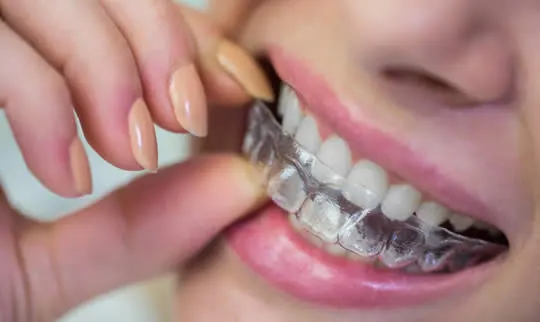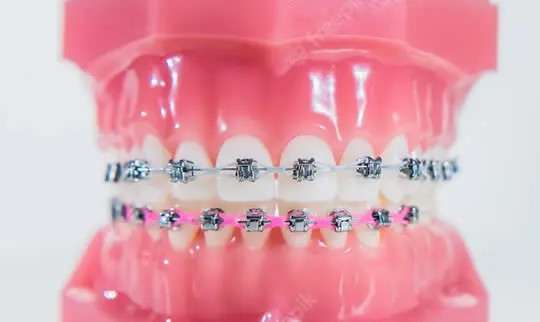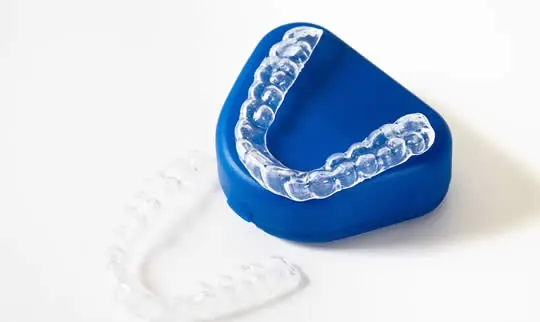When it comes to orthodontic treatment, two popular options that come to mind are aligners and braces. Both aligners and braces are effective in correcting dental misalignments and achieving a straighter smile. However, they differ in terms of their approach and characteristics. Aligners, often made of clear, removable plastic trays, provide a discreet and flexible option, while braces, consisting of metal or ceramic brackets and wires, offer a more traditional and comprehensive method. Understanding the distinctions between aligners and braces can help you make an informed decision when it comes to choosing the right orthodontic treatment for your needs.

What Are Braces?
and creates a straighter smile. They typically involve metal brackets bonded to the teeth, along with metal bands on the back teeth. An archwire, attached to the brackets using elastic o-rings, applies gentle pressure to shift the teeth into their desired positions. The archwire is periodically changed, with thicker wires used over time to exert greater force. Additional components like rubber bands or springs may be used for specific alignment needs. While traditional braces are visible due to their metal components, there are also more discreet options available, such as ceramic braces with tooth-colored or clear brackets.
The primary goal of braces is to guide teeth into proper alignment gradually. Through the application of consistent pressure, the archwire helps shift the teeth and remodel the surrounding bone and tissues. Once the desired alignment is achieved, the archwire aids in stabilizing the teeth to prevent shifting. Ultimately, whether you choose traditional braces or a more inconspicuous alternative, the end result is a confident and beautiful smile.
What are aligners?
Aligners serve as an excellent alternative to traditional braces for individuals seeking a discreet and flexible orthodontic treatment. Made from clear plastic, these virtually invisible aligners offer a more inconspicuous option for teeth alignment. Unlike braces, which consist of brackets and wires, aligners come in the form of removable trays that are custom-made to fit each patient’s unique dental structure.
As the treatment progresses, you will receive a set of aligners, typically wearing each tray for about one to two weeks before moving on to the next one in the series. The aligners are strategically designed to exert gradual and controlled force on specific teeth, gently nudging them into better positions over time. This gradual shifting allows for a more comfortable experience compared to the adjustments associated with braces.


Braces: Pros and Cons
Traditional braces have been a popular choice for orthodontic treatment due to their effectiveness and affordability. They provide precise control over the treatment process, allowing Dr. Azar to improve smiles successfully. However, one disadvantage is their visibility, which can impact self-esteem, especially for older patients. The bulky components of braces may cause discomfort and irritation in the mouth. Oral hygiene can be challenging, requiring extra care to clean around brackets and wires and prevent plaque buildup.
Despite these drawbacks, traditional braces remain a reliable option for achieving a straighter smile. Choosing braces should be based on individual needs and preferences, with guidance from Dr. Azar. Personalized recommendations can address concerns and optimize the orthodontic experience, ensuring the best outcome for patients.

Aligners: Pro and Cons
Pros:
Appearance: Aligners are clear and less noticeable than traditional braces, making them a popular choice for those concerned about aesthetics.
Removable: Aligners can be removed for eating, brushing, and special occasions, providing more flexibility and convenience compared to braces.
Comfort: Many people find aligners more comfortable than braces, as they don’t have wires or brackets that can cause irritation.
Easy Maintenance: Cleaning aligners is relatively simple compared to cleaning braces. Users can brush and rinse the aligners easily.
No Dietary Restrictions: Since aligners are removable, there are no restrictions on what you can eat or drink during the treatment.
Cons:
Compliance: Treatment success depends on wearing the aligners consistently for the recommended hours each day. Failure to do so can impact the effectiveness of the treatment.
Not Suitable for Severe Cases: Aligners may not be the best option for individuals with severe orthodontic issues. Traditional braces may be more effective in such cases.
Initial Discomfort: Users may experience initial discomfort or pressure when they switch to a new set of aligners. This discomfort typically subsides after a few days.
Treatment Duration: In some cases, aligner treatment may take longer than traditional braces, depending on the complexity of the orthodontic issues.
ADDITIONAL FREQUENTLY ASKED QUESTIONS ABOUT ALIGNERS VS. BRACES
How do aligners and braces differ in terms of treatment duration?
Can aligners or braces fix bite issues?
Both aligners and braces can address certain types of bite issues. However, traditional braces are generally more versatile and effective in treating complex bite problems, such as severe overbites or underbites. Aligners are better suited for mild to moderate bite irregularities.
Are there any age restrictions for aligners or braces?
There are no strict age restrictions for either aligners or braces. Both treatment options can be utilized by individuals of different age groups, including children, teenagers, and adults. The suitability of each option will depend on the specific dental needs and consultation with Dr. Azar.
Can aligners be lost or damaged easily?
Are there any restrictions on playing sports or musical instruments with aligners or braces?
Can aligners be used for teeth whitening or other cosmetic treatments?
Aligners are primarily designed for orthodontic purposes to align teeth. However, certain aligner systems may offer additional features, such as teeth whitening. It is recommended to discuss any cosmetic goals or desires with Dr. Azar to explore suitable options and ensure a comprehensive treatment plan.
How often are follow-up appointments necessary with aligners or braces?
Regular follow-up appointments are essential for both aligners and braces. With aligners, you will typically have check-ups every 4 to 6 weeks to monitor progress and receive new aligner trays. For braces, appointments are usually scheduled every 4 to 8 weeks for adjustments and monitoring of the treatment progress. These appointments allow Dr. Azar to assess the treatment’s effectiveness and make any necessary modifications to ensure optimal results.
Is there an orthodontist near me in Mission Hills that offers aligner or dental braces?
Yes. At our Mission Hills orthodontic office we offer braces and clear aligners to patients from Mission Hills and the surrounding area. Contact our office today to schedule an appointment.
Helpful Related Links
- American Dental Association (ADA). Glossary of Dental Terms.
- WebMD. What is an orthodontist
